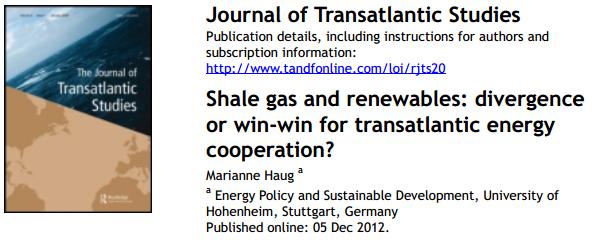It’s not news that the U.S. and Europe have been following different energy policies over the past few decades. However, according to one researcher, their divergence – with the U.S. leading ‘the shale gas revolution’ and Europe investing heavily in modern renewables – is a good thing for the development of both alternative-energy sources.

Ref: “Shale gas and renewables: divergence or win-win for transatlantic energy cooperation?”, by Marianne Haug, Journal of Transatlantic Studies, Vol. 10, No. 4, 358–373, published by Routledge, Taylor & Francis.
Writing in the Journal of Transatlantic Studies, Marianne Haug of the University of Hohenheim argues that although the transatlantic energy partners are committed to common goals – namely energy security, environmental sustainability, and economic competitiveness – the relative priority given to each has changed substantially since the early 1990s. Domestic issues, geopolitical concerns, differing resource bases, changing energy markets, government policy, public opinion, the accession of new countries to the EU and the choices of investors have all altered the landscape. To address these new challenges, both the U.S. and Europe have jointly and separately reached out to new markets, partners and collaboration arrangements.
Haug points to the example of the Kyoto Protocol as a turning point for energy policy. Before the 1997 agreement, which the U.S. did not ratify, energy security was considered the most important of the three goals. After Kyoto, European countries gave higher, if not equal, priority to environmental concerns. European countries entered into partnerships beyond the U.S. to develop low-carbon technologies, such as windmills, photovoltaic units, solar thermal hot-water installations and rapeseed biofuel. The EU also developed emission-trading systems, biofuel targets, energy-efficiency guidelines and standards, which stimulated the market for renewables and the industry as a whole.
In the U.S., where the European acceptance of the potential dangers of continued fossil-fuel use is not widespread, public and private investors have spent heavily on shale gas, building on existing fossil-fuel technology. The ability to extract shale gas efficiently could indeed ‘change the game’ for the U.S. and other countries by contributing to energy security and bringing lower prices. However, the industry is still in its infancy in Europe, due both to stricter regulations and public opinion. This may be changing, at least in the UK: the government stated in its March 2013 budget the intention to invest in its production.
Haug concludes that this parallel development of shale gas in the U.S. and renewables in Europe diversifies and enriches the world’s energy-supply choices. They are complementary technology pathways to limit import dependence for both partners and contribute to secure, affordable and sustainable energy for all. They are the result of transatlantic diversification – initially driven by energy-security then environmental concerns – through public and private R&D and supportive government policies. Now further cooperation between the transatlantic partners is needed to scale up the development of both forms of alternative energy for the benefit of the global energy community. This article is essential reading for anyone seeking to understand the major players’ current positions on alternative-energy sources and what the future might hold for global energy supply. Read the full article, free of charge, online: at http://dx.doi.org/ 10.1080/14794012.2012.734671.
Journal of Transatlantic Studies
http://www.tandfonline.com/doi/pdf/10.1080/14794012.2012.734671
Filed Under: News, Policy




